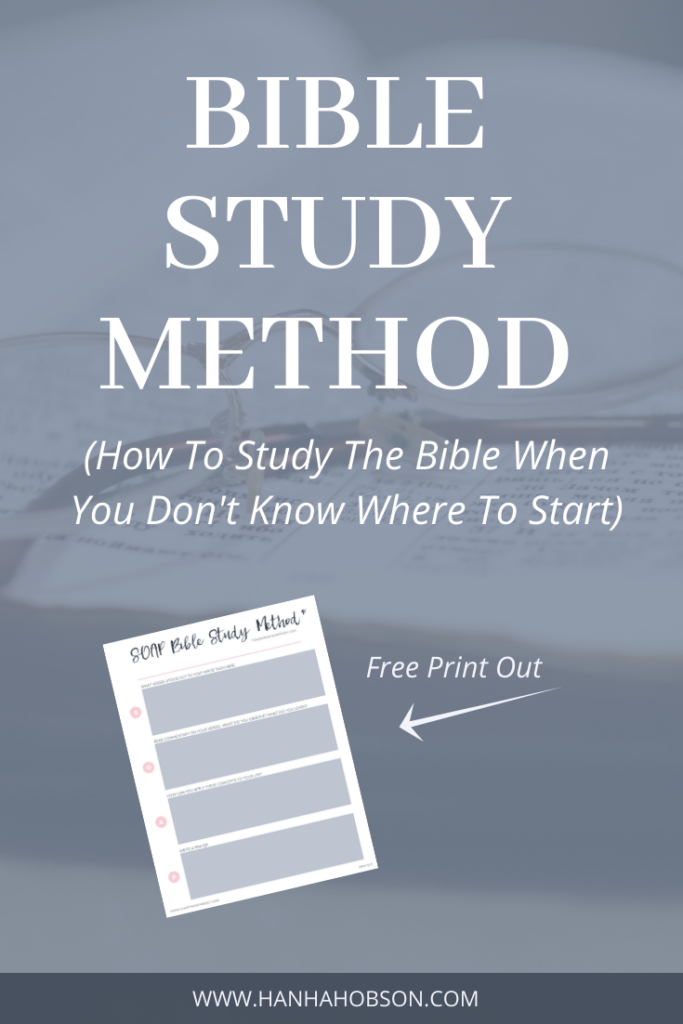I received this message on Facebook from a young woman:
“I’ve been sitting outside for the last hour crying to my dad about the longing I have to know God and to start building and growing that relationship with him. My problem was, I didn’t know how to start. Everyone says to read the Bible, but it’s a lot harder than it sounds. Sometimes it feels as though I’m just reading words on a page.”
I can relate to this feeling all too well. Although I would consider myself someone who has a strong relationship with God, I’ve struggled with reading my Bible too.
- What do I read?
- What do I do after I’ve read it?
- How do I get the revelation that the Holy Spirit is trying to teach me?
- How exactly do you meditate on His Word?

You’re not the only one who’s asked these questions. The fact is studying the Bible can be hard, but I’ve come to learn that the purpose of reading the Bible is to spend time with God and learn how we can become more like Him so that we can ultimately share the love of Christ with others.
So let’s dive right in to some questions that are super common when studying the Bible. This is the method that I use when studying God’s Word, but you can choose whichever way works best for you.
What do I read?
Here are three option that can help:
1. Choose a random book of the Bible.
Read a chapter each day until you until you finish the book. If you need help choosing a book, comment below and I’ll pick a book of the Bible for you. 🙂
2. Follow along on a devotional or reading plan on the Bible App.
Most devotionals have scriptures for you to read each day. But instead of reading one verse, click “Read the full chapter” so you can have more to study. Sometimes, the verses that are chosen won’t stick to you like others will.
3. Read from Genesis to Revelation.
You can do what my mom and I do best, and that is start with the book of Genesis and read more or less one chapter a day. Keep going until you finish the entire Bible, and when you’re done, start all over. When you do start over, feel free to read a different translations such as KJV or NLT. My go-to version is the NIV.
How do I study the Bible?
Once you’ve decided on the book or passage of scripture that you’re going to read, it’s time to study the Word. For me, I like to use the SOAP method along with Bible commentaries or study Bibles. This allows me to dig deeper, and helps me have a better understanding of the text.
SOAP stands for scripture, observation, application and prayer.
1. Scripture.
Start by underlining, highlighting, and taking notice of any verse(s) that jumps out at you. It could be a word or several verses. Hebrews 4:12 says that the Bible is alive and active so invite the Holy Spirit into your study time and ask Him to highlight something to you.
And feel free to read different translations of your verse. That sometimes makes a difference too!
2. Observation.
After you choose your key verse, write down any observations that stand out to you. This is the time where you can write down what you think the Holy Spirit is trying to speak to you through the passage. Perhaps you’re making some connections between the verses or you’ve gained insight or revelation behind the context and meaning.
Afterwards, look up commentary on the verse you have chosen. I love commentary by David Guzik and Matthew Henry. David Guzik goes through the text almost line by line (or phrase by phrase). For me, David Guzik commentary is a lot more straight forward and clear, which is helpful in trying to understand every single word or phrase that is used in the text.
On the other hand, Matthew Henry talks collectively about the entire text, verse by verse. To me, he provides a deeper analysis. But both are very good and will aide you as you study scripture.
3. Application.
I don’t spend a lot of time in this area, but you most certainly can. Be led by the Holy Spirit. See how you can take what you learn and apply it to your life that day or that week. Sometimes, you’ll have wide revelations and other times, it may be small guidance. Either way, this is how you allow the Word to be living and active.
4. Prayer.
Finish your study by praying. Ask God to help you apply the truth to your life, and include any other prayer requests that you have. Use that time to really talk to God about what you’re going through. Think of Him as a friend and update Him on what’s going on in your life.
If you feel uncomfortable sitting quiet, throw on some worship music and sing praises to the Lord. Just sing your favorite tracks and really meditate on the words that you are saying.
If this is uncomfortable, grab a prayer journal and write to God as if you’re writing a letter to a friend. You are not weird in any way for doing this. Praying in this way is actually how this blog was born. You never know what God will do through your prayers 🙂
Other Bible Study Methods:
Read the Context.
Sometimes, things become a lot more relatable whenever you understand the context in which the text was written. Sometimes, we can misinterpret scripture because we do not know the context. It can be helpful to study:
- Who wrote the book?
- When was the book written?
- Who was the book written to?
- Why was the book being written?
- What is the theme of the passage or chapter?
- What is the overall theme of the book?
- Historically, what was going on during the time?
Find the quoted scripture.
When someone (usually Jesus) is quoting scripture, try to find the verse that He is quoting. For example, when Jesus goes to the wilderness and is tempted by the devil (Matthew 4), He quotes scripture from the Old Testament.
Research what that scripture is, and ask yourself why He used those particular verses or discover the context and meaning behind the verse.
Look up the Hebrew or Greek definitions.
If a word jumps out at you, try looking up the literal definition of the word. Blue Letter Bible is a great resource for this. This can bring new meaning to the text, and help you understand the divine inspiration in which the text was written. As a note, the Old Testament was written in Hebrew while the New Testament was written in Greek.
I hope this Bible study method helps! Let me know what bible study techniques you use in the comments below. And don’t forget to grab your free worksheet below. It is a practical print-out you can use the next time you study the Bible!

+ show Comments
- Hide Comments
add a comment